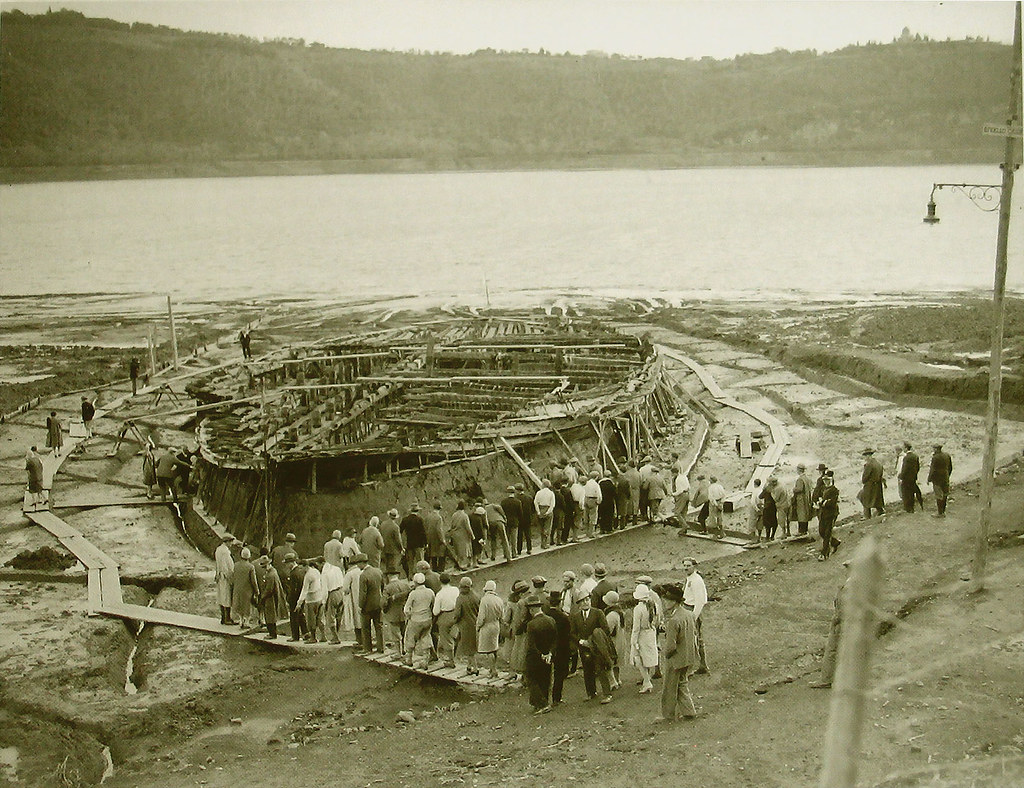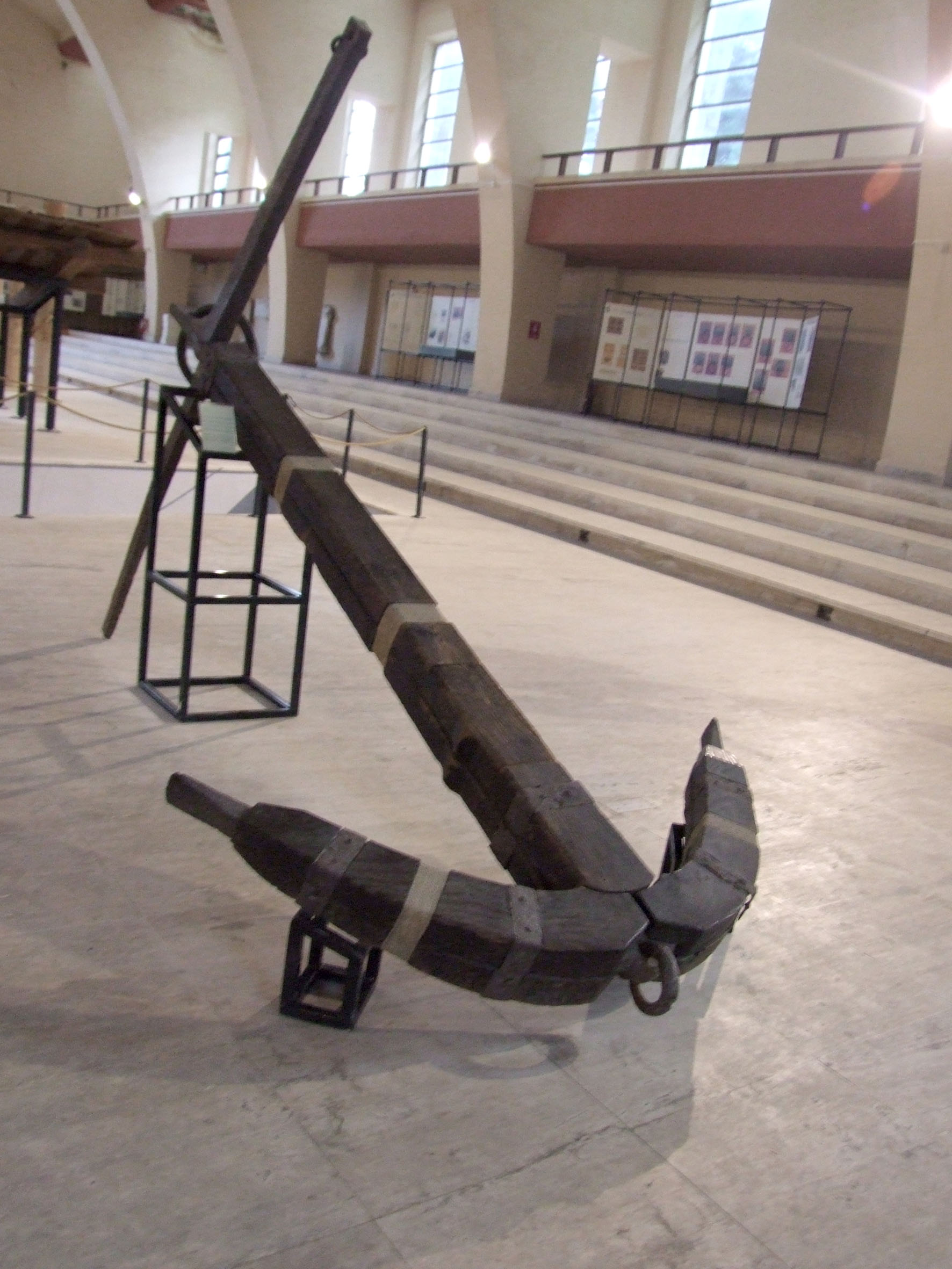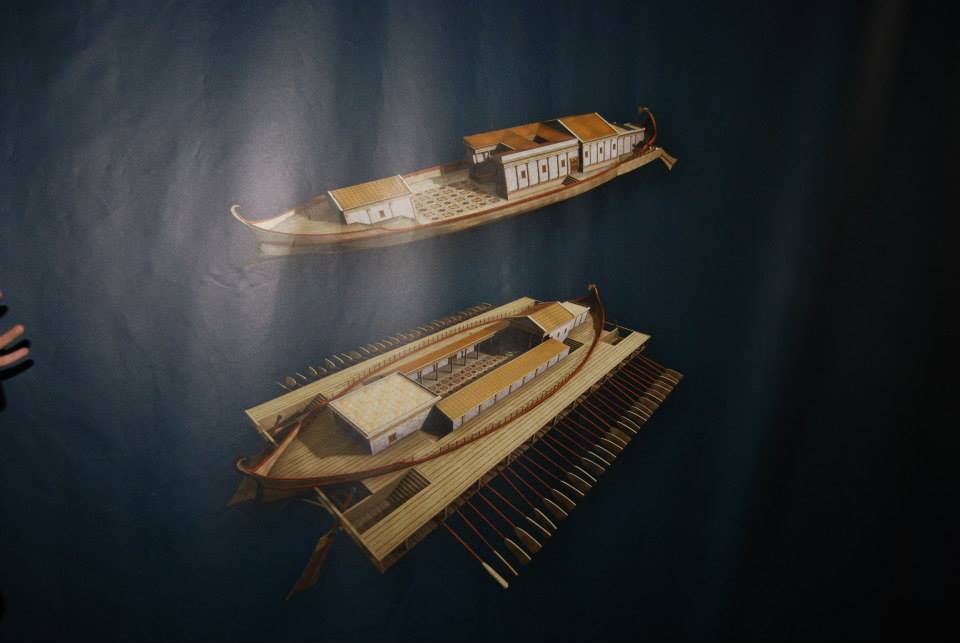This bronze Medusa fitting is one of the most important remains of Caligula Nemi ships - floating palaces made with exceptional richness: the ships were clearly ostentatious luxury vessels used as an expression of power. The larger ship was essentially an elaborate floating palace, which contained quantities of marble, mosaic floors and even baths.
Before finding the ships local fishermen had always been aware of the existence of the wrecks, and had explored them and removed small artifacts, often using grappling hooks to pull up pieces, which they sold to tourists. In 1446, Cardinal Prospero Colonna and Leon Battista Alberti followed up on the stories regarding the remains and discovered them lying at a depth of 18.3 meters (60 ft), which at that time was too deep for effective salvage. In 1895, with the support of the Ministry of Education, Eliseo Borghi began a systematic study of the wreck site and discovered the site contained two wrecks instead of the one expected. In 1927, the Italian dictator Benito Mussolini ordered Guido Ucelli to drain the lake and recover the ships. With the help of the navy, army, industry, and private individuals, an ancient Roman underground water conduit linking the lake to farms outside the crater was reactivated. The ships come to surface after 2000 years underwater.
As one of his royal passions, Emperor Caligula ordered several large barges to be built to use on Lake Nemi. For centuries scholars and historians have debated Caligua’s reason for building the barges. Some contend that Caligula built the barges to show the rulers of Syracuse, Sicily, and the Ptolemaic rulers in Egypt that Rome could match any luxurious pleasure barges that they built. Caligula bragged that his ships were the most luxurious in the Hellenistic world. The discovery proved that the Romans were capable of building large ships. Before the recovery of the Nemi ships, scholars often ridiculed the idea that the Romans were capable of building a ship as big as some ancient sources reported the Roman grain carriers were.
Two vessels, which were designated in modern times as Prima Nave and Seconda Nave, (First Ship and Second Ship), had dimensions of 67m x 19m and 71m x 24m respectively. Placed together, they would have taken up much of the area of a football pitch. It is generally agreed that one of the ships was designed to be a floating temple to Diana, or others of the many deities that were then in vogue, while the other vessel may have been used as a palace afloat for the Emperor and his court where he undoubtedly would have indulged in many of the depravities that are attributed to him. It is apparent that both ships were originally built using the standard sea-going shipbuilding techniques and materials of the day and that they were fitted out to an extremely high standard of luxury and decoration. Nothing is known of the circumstances in which the ships sank. There is speculation that they simply floated on the lake until they leaked and became waterlogged. Other commentators have conjectured that Caligula’s successor, Claudius, a more benign and prudent ruler, may have had them sunk to help obliterate the memory of his decadent predecessor.
Seutonius, the Roman historian described the two biggest barges as being built of cedar wood adorned with jeweled prows, rich sculpture, vessels of gold and silver, sails of purple silk, and bathrooms of alabaster and bronze. The floors were paved with glass mosaic, the windows and door frames were made of bronze, and many of the decorations were priceless. The Romans made ball bearings out of lead and they probably used the ball bearings on the Nemi ships to make the statues of the gods rotate or to move the windlasses.
These floating palaces were attached to the shore by chains, and bridges were built across the water to link with the ships. According to some historical accounts, Caligula’s ships were the scenes of orgies, murder, cruelty, music, and sport and he supposedly spent much of his inheritance from his Uncle Tiberius to create his Nemi Ship retreat.
Many people concluded that the Nemi Ships were pleasure barges, but Pliny the Younger disagreed. He said that since Lake Nemi was sacred, Roman law prohibited ships from sailing on it. Pliny argued that Caligula had received a religious exemption for his ships.
Both ships had several hand operated bilge pumps that worked like a modern bucket dredge, the oldest example of this type of bilge pump ever found. The pumps were also operated by what may have been the oldest crank handles yet discovered; the reconstruction of the cranked pump which was assembled from fragments, including a wooden disk and an eccentric peg, has been dismissed as "archaeological fantasy". Piston pumps supplied the two ships with hot and cold running water via lead pipes. The hot water supplied baths while the cold operated fountains and supplied drinking water. This plumbing technology was later lost and only re-discovered in the Middle Ages.
Each ship contained a rotating statue platform. One platform was mounted on caged bronze balls and is the earliest example of the thrust ball bearing previously believed to have been first envisioned by Leonardo da Vinci but only developed much later. Previous Roman ball bearing finds (used for water wheel axles in thermal baths) had a lenticular shape. The second platform was almost identical in design but used cylindrical bearings. Although consensus is that the platforms were meant for displaying statues, it has also been suggested that they may have been platforms for deck cranes used to load supplies
Unfortunately the ships were destroyed by fire in World War II on the night of May 31, 1944. Several US army shells hit the Museum around 8 pm, causing little damage but forcing the German artillery to leave the area. Around two hours later, smoke was seen coming from the Museum.
Before finding the ships local fishermen had always been aware of the existence of the wrecks, and had explored them and removed small artifacts, often using grappling hooks to pull up pieces, which they sold to tourists. In 1446, Cardinal Prospero Colonna and Leon Battista Alberti followed up on the stories regarding the remains and discovered them lying at a depth of 18.3 meters (60 ft), which at that time was too deep for effective salvage. In 1895, with the support of the Ministry of Education, Eliseo Borghi began a systematic study of the wreck site and discovered the site contained two wrecks instead of the one expected. In 1927, the Italian dictator Benito Mussolini ordered Guido Ucelli to drain the lake and recover the ships. With the help of the navy, army, industry, and private individuals, an ancient Roman underground water conduit linking the lake to farms outside the crater was reactivated. The ships come to surface after 2000 years underwater.
As one of his royal passions, Emperor Caligula ordered several large barges to be built to use on Lake Nemi. For centuries scholars and historians have debated Caligua’s reason for building the barges. Some contend that Caligula built the barges to show the rulers of Syracuse, Sicily, and the Ptolemaic rulers in Egypt that Rome could match any luxurious pleasure barges that they built. Caligula bragged that his ships were the most luxurious in the Hellenistic world. The discovery proved that the Romans were capable of building large ships. Before the recovery of the Nemi ships, scholars often ridiculed the idea that the Romans were capable of building a ship as big as some ancient sources reported the Roman grain carriers were.
Two vessels, which were designated in modern times as Prima Nave and Seconda Nave, (First Ship and Second Ship), had dimensions of 67m x 19m and 71m x 24m respectively. Placed together, they would have taken up much of the area of a football pitch. It is generally agreed that one of the ships was designed to be a floating temple to Diana, or others of the many deities that were then in vogue, while the other vessel may have been used as a palace afloat for the Emperor and his court where he undoubtedly would have indulged in many of the depravities that are attributed to him. It is apparent that both ships were originally built using the standard sea-going shipbuilding techniques and materials of the day and that they were fitted out to an extremely high standard of luxury and decoration. Nothing is known of the circumstances in which the ships sank. There is speculation that they simply floated on the lake until they leaked and became waterlogged. Other commentators have conjectured that Caligula’s successor, Claudius, a more benign and prudent ruler, may have had them sunk to help obliterate the memory of his decadent predecessor.
Seutonius, the Roman historian described the two biggest barges as being built of cedar wood adorned with jeweled prows, rich sculpture, vessels of gold and silver, sails of purple silk, and bathrooms of alabaster and bronze. The floors were paved with glass mosaic, the windows and door frames were made of bronze, and many of the decorations were priceless. The Romans made ball bearings out of lead and they probably used the ball bearings on the Nemi ships to make the statues of the gods rotate or to move the windlasses.
These floating palaces were attached to the shore by chains, and bridges were built across the water to link with the ships. According to some historical accounts, Caligula’s ships were the scenes of orgies, murder, cruelty, music, and sport and he supposedly spent much of his inheritance from his Uncle Tiberius to create his Nemi Ship retreat.
Many people concluded that the Nemi Ships were pleasure barges, but Pliny the Younger disagreed. He said that since Lake Nemi was sacred, Roman law prohibited ships from sailing on it. Pliny argued that Caligula had received a religious exemption for his ships.
Both ships had several hand operated bilge pumps that worked like a modern bucket dredge, the oldest example of this type of bilge pump ever found. The pumps were also operated by what may have been the oldest crank handles yet discovered; the reconstruction of the cranked pump which was assembled from fragments, including a wooden disk and an eccentric peg, has been dismissed as "archaeological fantasy". Piston pumps supplied the two ships with hot and cold running water via lead pipes. The hot water supplied baths while the cold operated fountains and supplied drinking water. This plumbing technology was later lost and only re-discovered in the Middle Ages.
Each ship contained a rotating statue platform. One platform was mounted on caged bronze balls and is the earliest example of the thrust ball bearing previously believed to have been first envisioned by Leonardo da Vinci but only developed much later. Previous Roman ball bearing finds (used for water wheel axles in thermal baths) had a lenticular shape. The second platform was almost identical in design but used cylindrical bearings. Although consensus is that the platforms were meant for displaying statues, it has also been suggested that they may have been platforms for deck cranes used to load supplies
Unfortunately the ships were destroyed by fire in World War II on the night of May 31, 1944. Several US army shells hit the Museum around 8 pm, causing little damage but forcing the German artillery to leave the area. Around two hours later, smoke was seen coming from the Museum.





0 comments:
Post a Comment